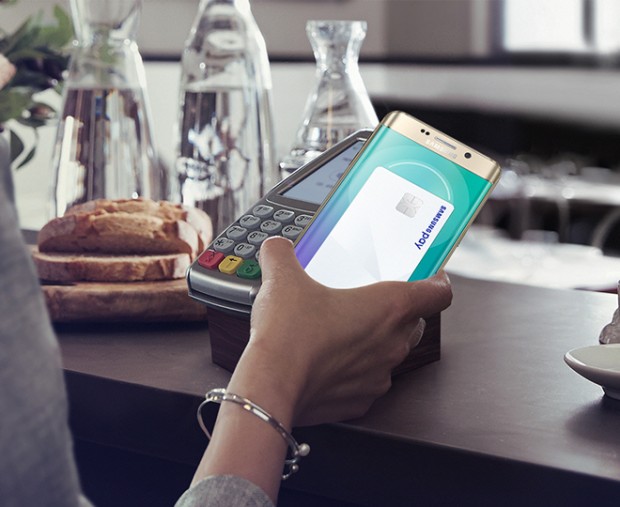- California Assembly OKs highest minimum wage in nation
- S. Korea unveils first graphic cigarette warnings
- US joins with South Korea, Japan in bid to deter North Korea
- LPGA golfer Chun In-gee finally back in action
- S. Korea won’t be top seed in final World Cup qualification round
- US men’s soccer misses 2nd straight Olympics
- US back on track in qualifying with 4-0 win over Guatemala
- High-intensity workout injuries spawn cottage industry
- CDC expands range of Zika mosquitoes into parts of Northeast
- Who knew? ‘The Walking Dead’ is helping families connect
Samsung eyes top spot in mobile payment market

A user demonstrates Samsung Electronics Co.’s Samsung Pay with the Galaxy S6 Edge+ in this photo released by Samsung on Aug. 13, 2015. (Yonhap)
SEOUL (Yonhap) — Buying a meal or other daily necessities with Samsung Pay, Samsung Electronics Co.’s latest mobile payment tool, is no different from paying with a credit card.
Launched in South Korea in late August, Samsung Pay enables users to make purchases at any shop with conventional credit card machines, unlike other existing mobile payment tools that require retailers to have separate terminals to handle them.
The tool is Samsung’s latest effort to become a leading player in the mobile payment market, though the company is a latecomer to the industry expected to grow sharply down the road with the rise of mobile device use in everyday life.
Industry watchers say Samsung Pay marks “one giant leap” not only for the global mobile payment industry by providing never-before-seen convenience, but also for the South Korean tech giant trying to shake off its image as a “fast-follower” and emerge as a “first-mover.”
“We can see great potential in Samsung Pay. Unlike other Internet-based mobile payment tools, Samsung’s service, which can be used offline, can appeal to a wider scope of users,” Jeff Kim, an analyst at Hyundai Securities Co.
“Once consumers get more used to making payments with mobile devices, Samsung Pay will be able to enjoy strong demand.”
Samsung has succeeded in coming up with the user-friendly payment tool by combining the near field communication (NFC) technology used by its rivals with magnetic secure transmission (MST) and bar code technologies.
The MST technology is significant as it is compatible with conventional credit card devices, meaning it can be used in a larger number of shops compared with Apple Inc.’s Apple Pay.
Apply Pay holds a strong footing in the U.S. market thanks to the number of iPhone fans, but it is facing challenges because only a limited number of shops have devices with the NFC technology. In contrast, Samsung Pay can be used at some 90 percent of the shops there.
Upon its debut in the domestic market, Samsung Pay has taken off. Industry data shows around 200,000 cards subscribed to the Samsung Pay system within eight days after its launch.
Samsung Card Co., a sister company of Samsung Electronics, said during the pilot run of Samsung Pay between July and August, around 86.4 percent of users made payments through the platform more than once, implying local consumers’ reaction to the service was positive.
Previously, South Korea’s mobile payment system market has been flooded with numerous solutions from virtually every local Internet and financial company.
Daum Kakao Corp., the operator of South Korea’s most beloved mobile messenger KakaoTalk, launched its own payment tool, dubbed Kakao Pay, in September last year. Naver Corp., South Korea’s top Internet portal operator also joined the move in June, while NHN Entertainment Corp. also kicked off the Payco platform.
Payco was significant in that a user can make payments offline within around four hours even after a smartphone is turned off. In turn, each player struggled to grab the attention of users through different features.
But none of the platforms have shown as wide a scope of usage as Samsung Pay, allowing Samsung’s service to quickly rise as one of the leading mobile payment tools in the country.
Earlier this week, even Woori Bank, South Korea’s No. 2 player, said users can now use Samsung Pay on its 1,000 automated teller machines in the country.
Samsung, however, is facing challenges in the market as Apple is not the only rival in the global realm.
Google Inc., which provides the Android platform to Samsung, just released Android Pay, which is expected to pose a tougher challenge to the South Korean tech behemoth down the road.
Others said Samsung Pay may face huddles if the NFC technology manages to rise as the mainstream technology in the industry.
“But Android Pay will be of less concern for Samsung,” Kim said. “Unlike Apple, Google and Samsung need each other. They will find ways to coexist together.”
The significance of Samsung Pay’s rise, however, is seen as not being limited to the mobile platform market. Industry watchers said Samsung Pay has raised hopes for Samsung’s attempt to establish its own ecosystem in the sea of technology.
Specifically, Samsung’s archrival Apple Inc. boasts its own world of technology from FaceTime to iTunes, making iPhones stand out from other devices. But Samsung’s efforts to focus on the content side has not been so successful.
Samsung discontinued its own messenger system ChatOn in February this year. It also dissolved the Mobile Solution Center (MSC) late last year, failing to develop a sustainable content for its mobile platforms.
While Samsung ambitiously rolled out a music-streaming service “Milk,” but it also failed to become a sensation in the industry.
“Frankly speaking, it is believed that Samsung’s executives consider content as mere tools to sell more devices, rather than building an ecosystem of Samsung programs,” a former Samsung MSC official said. “But the new device is expected to change that attitude.”
















for trousers
May 29, 2016 at 2:10 PM
Forum Advance